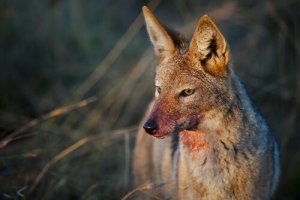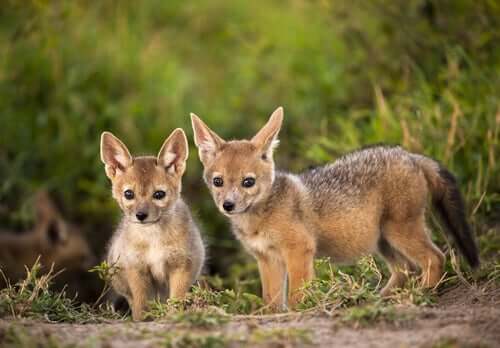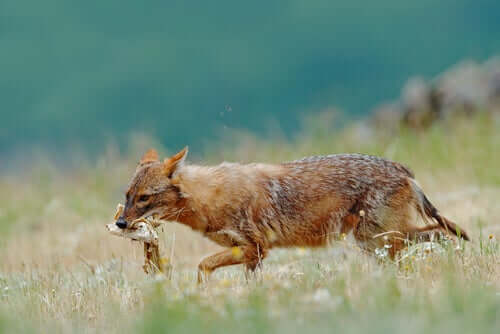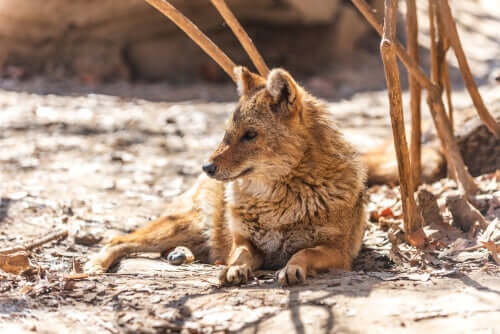Why Does the Golden Jackal Have Such a Bad Reputation?


Written and verified by biochemistry Luz Eduviges Thomas-Romero
The golden jackal, also known in Latin as Canis aureus, is one of the canid species with the greatest global distribution. It inhabits many areas of Europe and Southern Asia.
The expansion of this species, currently ongoing in European territory, is a source of concern to researchers, environmentalists, and locals. This concern is mainly centered on the possible negative effects that the presence of this animal could have in the area.
The fear that they’ll have a negative impact on other populations of wildlife animals means that they have a reputation as vicious predators. Because of this, there’s currently uncertainty in regard to the conservation policies of the golden jackal.
There’s even the need to clarify the origins of these jackal populations. This species sort of remained absent in most of Europe until the 19th century. This is when they began to expand slowly in the territory. The dynamics of their distribution changed since the end of the 20th century, which is when the species began to expand quite rapidly in Europe.
Habitat, reproduction and life cycle

The golden jackal is the most widely distributed species of jackals. This species prefers open fields, arid meadows, and steppes. They have a lot of energy, probably because they’re hunters.
As for their reproduction, this species lives in pairs and is strictly monogamous. In most jackal families, there are one or two adult members referred to as “helpers.”
The helpers are the jackals that remain with their parents for at least a year after reaching sexual maturity. Without reproducing, that is. They stay in order to help care for the next litter, which can be as numerous as nine cubs.
The gestation period of a golden jackal is of 63 days. The birth weight is 7 to 9 ounces and the cubs get to breastfeed for about eight weeks. Both parents provide them with food and protection. Moreover, according to some studies, this animal reaches sexual maturity at the age of 11 months and they can live up to 16 years in captivity.
Jackals are omnivorous, so they don’t just eat meat. In fact, golden jackals consume about 54% of animal-sourced food and 46% from plants.
They like eating large prey such as young gazelles. However, they also eat rodents, hares, birds, and even their eggs. Also, reptiles, frogs, fish, insects, and fruit. When they are forced to, they have no problem feeding on carrion.
Economic importance to humans: positive and negative
Golden jackals are an asset to the world’s health as they eat some of the garbage and carrion in the cities and towns they inhabit. In addition, they benefit agriculture by keeping the population of rodents at bay.
When this animal breeds in captivity it can be quite tame. They’re quite domestic and behave similarly to a dog. Except for the fact that they remain shy with strangers and don’t allow them to get too close.
As with everything, jackals can also have a negative impact on the human way of life, because they often assault crops and attack sheep herds. In addition, being wild hunting animals, these animals could easily contract and spread rabies.
Conservation status of the golden jackal

The golden jackal prevails in Europe without any threat of extinction. According to the categories and criteria of the IUCN Red List of Threatened Species, this is a species of least concern.
Of course, the golden jackal is considered to be a potentially invasive species in all Baltic states and its status requires a careful review. For an alien species to become invasive, it must arrive, survive and thrive.
Even though there’s an exponential increase in their population size, as in Hungary, the other two criteria aren’t yet met.
Is the golden jackal singled out for no good reason?

The expansion of the golden jackal to northern Europe is obviously the result of natural migration. In addition, there’s no evidence of their detrimental effect on local wildlife. There are also no major complaints of golden jackals causing damage to domestic animals reported from Europe.
Researchers believe that the occasional reports of jackals attacking cattle are exaggerations, and it may also be due to misidentification. This conclusion derives from the inspection, and forensic genetics used in some of the reported cases.
In regard to supposed health risks, recent studies indicate that the parasite load in the European golden jackal is similar or lower than that of other carnivores. These include the red fox and gray wolf in the region. There are no reports of jackal attacking people either.
For these reasons, the concerns about serious negative impacts due to the expansion of the golden jackal in Europe are unfounded.
What measures should we take?
The expansion of the golden jackal in large territories seems to justify the beginning of international activities focused on the management of the species in Europe. Various agencies are suggesting that it’s time to develop cross-border management strategies and documents.
These strategies would be similar to the management of the great carnivores of Europe. The golden jackal appears under the species of Annex V in the European Union Habitats Directive. As such, they must receive legal protection in all EU member states. Note that breaking this rule has several legal implications.
We hope you’ve enjoyed this article.
The golden jackal, also known in Latin as Canis aureus, is one of the canid species with the greatest global distribution. It inhabits many areas of Europe and Southern Asia.
The expansion of this species, currently ongoing in European territory, is a source of concern to researchers, environmentalists, and locals. This concern is mainly centered on the possible negative effects that the presence of this animal could have in the area.
The fear that they’ll have a negative impact on other populations of wildlife animals means that they have a reputation as vicious predators. Because of this, there’s currently uncertainty in regard to the conservation policies of the golden jackal.
There’s even the need to clarify the origins of these jackal populations. This species sort of remained absent in most of Europe until the 19th century. This is when they began to expand slowly in the territory. The dynamics of their distribution changed since the end of the 20th century, which is when the species began to expand quite rapidly in Europe.
Habitat, reproduction and life cycle

The golden jackal is the most widely distributed species of jackals. This species prefers open fields, arid meadows, and steppes. They have a lot of energy, probably because they’re hunters.
As for their reproduction, this species lives in pairs and is strictly monogamous. In most jackal families, there are one or two adult members referred to as “helpers.”
The helpers are the jackals that remain with their parents for at least a year after reaching sexual maturity. Without reproducing, that is. They stay in order to help care for the next litter, which can be as numerous as nine cubs.
The gestation period of a golden jackal is of 63 days. The birth weight is 7 to 9 ounces and the cubs get to breastfeed for about eight weeks. Both parents provide them with food and protection. Moreover, according to some studies, this animal reaches sexual maturity at the age of 11 months and they can live up to 16 years in captivity.
Jackals are omnivorous, so they don’t just eat meat. In fact, golden jackals consume about 54% of animal-sourced food and 46% from plants.
They like eating large prey such as young gazelles. However, they also eat rodents, hares, birds, and even their eggs. Also, reptiles, frogs, fish, insects, and fruit. When they are forced to, they have no problem feeding on carrion.
Economic importance to humans: positive and negative
Golden jackals are an asset to the world’s health as they eat some of the garbage and carrion in the cities and towns they inhabit. In addition, they benefit agriculture by keeping the population of rodents at bay.
When this animal breeds in captivity it can be quite tame. They’re quite domestic and behave similarly to a dog. Except for the fact that they remain shy with strangers and don’t allow them to get too close.
As with everything, jackals can also have a negative impact on the human way of life, because they often assault crops and attack sheep herds. In addition, being wild hunting animals, these animals could easily contract and spread rabies.
Conservation status of the golden jackal

The golden jackal prevails in Europe without any threat of extinction. According to the categories and criteria of the IUCN Red List of Threatened Species, this is a species of least concern.
Of course, the golden jackal is considered to be a potentially invasive species in all Baltic states and its status requires a careful review. For an alien species to become invasive, it must arrive, survive and thrive.
Even though there’s an exponential increase in their population size, as in Hungary, the other two criteria aren’t yet met.
Is the golden jackal singled out for no good reason?

The expansion of the golden jackal to northern Europe is obviously the result of natural migration. In addition, there’s no evidence of their detrimental effect on local wildlife. There are also no major complaints of golden jackals causing damage to domestic animals reported from Europe.
Researchers believe that the occasional reports of jackals attacking cattle are exaggerations, and it may also be due to misidentification. This conclusion derives from the inspection, and forensic genetics used in some of the reported cases.
In regard to supposed health risks, recent studies indicate that the parasite load in the European golden jackal is similar or lower than that of other carnivores. These include the red fox and gray wolf in the region. There are no reports of jackal attacking people either.
For these reasons, the concerns about serious negative impacts due to the expansion of the golden jackal in Europe are unfounded.
What measures should we take?
The expansion of the golden jackal in large territories seems to justify the beginning of international activities focused on the management of the species in Europe. Various agencies are suggesting that it’s time to develop cross-border management strategies and documents.
These strategies would be similar to the management of the great carnivores of Europe. The golden jackal appears under the species of Annex V in the European Union Habitats Directive. As such, they must receive legal protection in all EU member states. Note that breaking this rule has several legal implications.
We hope you’ve enjoyed this article.
All cited sources were thoroughly reviewed by our team to ensure their quality, reliability, currency, and validity. The bibliography of this article was considered reliable and of academic or scientific accuracy.
- Trouwborst, A., Krofel, M., & Linnell, J. D. (2015). Legal implications of range expansions in a terrestrial carnivore: the case of the golden jackal (Canis aureus) in Europe. Biodiversity and Conservation, 24(10), 2593-2610.
- Macdonald, D. W. (1979). The flexible social system of the golden jackal, Canis aureus. Behavioral Ecology and Sociobiology, 5(1), 17-38.
- Giannatos, G., Marinos, Y., Maragou, P., & Catsadorakis, G. (2005). The status of the golden jackal (Canis aureus L.) in Greece. Belgian Journal of Zoology, 135(2), 145.
- Yom-Tov, Y., Ashkenazi, S., & Viner, O. (1995). Cattle predation by the golden jackal Canis aureus in the Golan Heights, Israel. Biological Conservation, 73(1), 19-22.
This text is provided for informational purposes only and does not replace consultation with a professional. If in doubt, consult your specialist.








